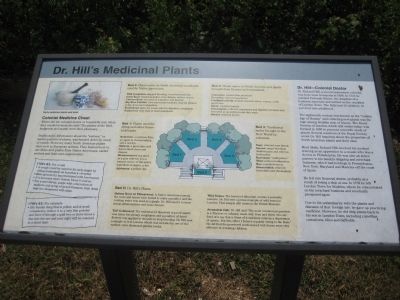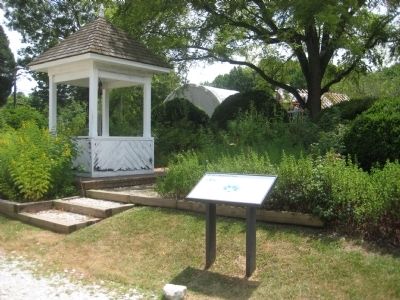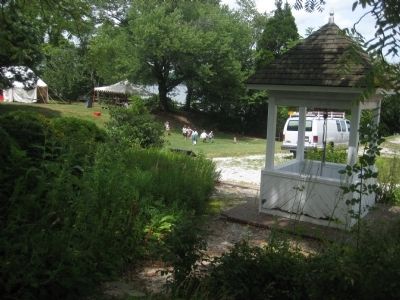Edgewater in Anne Arundel County, Maryland — The American Northeast (Mid-Atlantic)
Dr. Hill's Medicinal Plants
Colonial Medicine Chest
Where did the colonial doctor or housewife turn when they needed to treat the sick? The plants of the field, hedgerow and marsh were their pharmacy.
Traditionally, information about the "vertues," or useful qualities of plants, was handed down by word of mouth. However, many North American plants were new to European settlers. They learned how to use these new plants from Native Americans, earlier settlers and their own experiments.
1700's RX: For a cold
* A cough could be cured in its early stages by riding moderately on horseback everyday.
* Take ground ivy tea sweetened with horehound.
* If it becomes more violent, bleed 8 ounces.
* For a sore throat, purge with a decoction of mallows and syrup of peach blossom, then drink sage tea sharpened with alum.
1700's RX: For cataracts
* Dry human dung that is yellow and of good consistency, reduce it to a very fine power and blow it through a quill two or three times a day into the eye and your sight will be restored in a short time.
[diagram of colonial plant beds]
Bed 1: Plants used for dying and other household tasks.
Bedstraw: a mattress filler, an agent in cheesemaking and a red dye
Mullein: a green dye; soft leaves lined shoes and diapers
Meadowsweet: tea used as a pain reliever, it is a natural source of the active ingredient in asprin, a dye
Agrimony: a yellow dye
Bed 2: Plants native to North American woodlands used by Native Americans
Wild Geranium: stopped bleeding, cured hemorrhoids
Orris Root: treated jaundice, liver disease, kidney stones
Culvers Root: tea used as a laxative and diuretic
Big Blue Lobelia: root teas treated syphilis, leaf tes treated colds, fever and indigestion
Turtlehead: salve for sores, teas for digestive complaints
Snakeroot: teas used to treat snakebites
Bed 3: Plants native to North America and plants brought from Europe and naturalized
Calendula: treated skin problems
Feverfew: relieved headaches
Cardinal Lobelia: treated stomach aches, worms, colds and fevers
Tansy: repelled insects
Elecampane: relieved respiratory and digestive troubles and was used as an antibacterial skin wash
Burnet: relieved fevers
Bed 4: Traditional herbs brought to the New World by colonists
Sage: relieved sore throat
Yarrow: stops bleeding, deadens pain and relieves toothaches
Rosemary: "antihysteric"
Mint: relieved indigestion
Rue: repelled insects
Horseradish: relieved bronchitis and rheumatism
Bed 5: Dr. Hill's Plants
Quinzy Root or Throatwort: A Native American Remedy, the roots and leaves were boiled to make a poultice and the cooking water was used as a gargle. Dr. Hill used it to treat throat inflammations and some tumors.
Tall Goldenrod: The essential oil dissolved in proof spirits was taken for urinary complaints and a poultice of dried flowers was applied to wounds to stop bleeding. Dr. Hill sent a sample of it to London which was included in one of the earliest color illustrated garden books.
Wild Senna: The leaves of this plant contain a powerful laxative. Dr. Hill sent a pressed sample of wild senna to London. That sample still exists in the British Museum.
Jerusalem Oak: Dr. Hill said "The most common preparation is a Tincture or infusion made with Rum and those who are fond of it say that a Glass of it suddenly relieves a depression of spirits...But this effect I believe is partly owing to the Rum." He did find the powdered seeds mixed with honey were very effective in worming children.
Dr. Hill - Colonial Doctor
Dr. Richard Hill, a second generation colonist, was born near Annapolis in 1698. In 1721 he married Deborah Moore, the daughter of a business associate and settled on the outskirts of London Town. The Hills had 12 children; 10 survived into adulthood.
The
eighteenth century was known as the "Golden Age of Botany" and collecting new plants was the rage among wealthy men of leisure. The Royal Society of London - which still exists today - was formed in 1660 to promote scientific study of plants. Several members of the Royal Society wrote Dr. Hill inquiring about the properties of North American plants and their uses.
. Most likely, Richard Hill received his medical training as an apprentice to a cousin who was a doctor in Philadelphia. He was also an active partner in his family's shipping and merchant business, which had holdings in Pennsylvania, New York, Maryland and Madeira - off the coast of Spain.
He fell into financial straits, probably as a result of losing a ship at sea. In 1739 he left London Town for Madeira, where he concentrated on his merchant business and eventually prospered again.
Due to his unfamiliarity with the plants and diseases of that foreign isle, he gave up practicing medicine. However, he did ship plants back to his son in London Town, including camellias, carnations, lilies and daffodils.
Topics. This historical marker is listed in these topic lists: Colonial Era • Industry & Commerce • Settlements & Settlers. A significant historical year for this entry is 1698.
Location. 38° 56.481′ N, 76° 32.397′ W. Marker is in Edgewater , Maryland, in Anne Arundel County. Marker can be reached from Londontown Road, 1.3 miles north of Mayo Road (Route 253). Marker is on the grounds of London Town Park, at the end of Londowntown Road, near the brick house. Touch for map. Marker is in this post office area: Edgewater MD 21037, United States of America. Touch for directions.
Other nearby markers. At least 8 other markers are within walking distance of this marker. London Town Publik House (a few steps from this marker); The Lord Mayor's Tenement (within shouting distance of this marker); William Brown House (within shouting distance of this marker); Archaeology at London Town (within shouting distance of this marker); Establishing a Colonial Town (within shouting distance of this marker); The Ferry at London Town (within shouting distance of this marker); London Town Ferry (within shouting distance of this marker); Scott Street (within shouting distance of this marker). Touch for a list and map of all markers in Edgewater.
Credits. This page was last revised on December 10, 2022. It was originally submitted on September 3, 2009, by F. Robby of Baltimore, Maryland. This page has been viewed 965 times since then and 21 times this year. Photos: 1, 2, 3. submitted on September 3, 2009, by F. Robby of Baltimore, Maryland.


